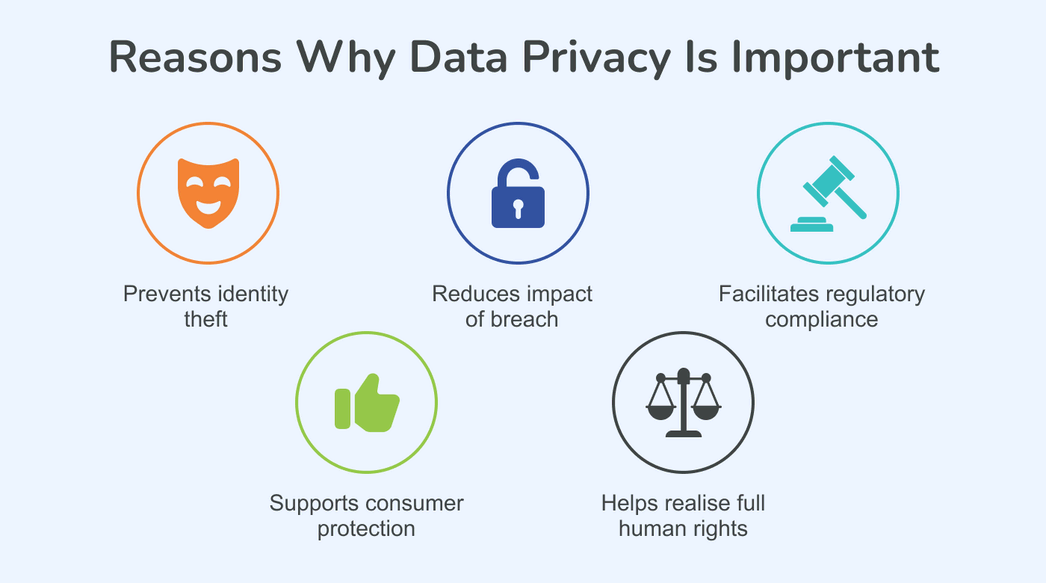Important Privacy Rules Every Company Must Implement for Data Security
 Logeshwaran N
Logeshwaran N
In today's data-driven world, privacy has become one of the most important concerns for individuals and organizations alike. With increasing awareness about personal data security, governments and regulatory bodies around the globe have enacted privacy laws and frameworks to protect individuals' personal information. The General Data Protection Regulation (GDPR) in Europe and the California Consumer Privacy Act (CCPA) in the United States are just two examples of such regulatory initiatives.
For organizations, complying with these laws means adhering to a set of privacy principles that guide the responsible collection, processing, storage, and sharing of personal data. Failure to follow these principles can result in significant legal, financial, and reputational consequences.
In this article, we will explore the key privacy principles that organizations must adhere to when handling personal data. Additionally, we will provide a real-world scenario to illustrate the practical application of these principles in an organization.

Core Privacy Principles
- Lawfulness, Fairness, and Transparency
This principle mandates that personal data should be processed lawfully, fairly, and in a transparent manner. Organizations must have a legitimate reason (legal basis) to collect and process personal data, such as obtaining the individual’s consent or processing the data as part of a contractual obligation.
Lawfulness: Organizations must ensure that the data processing activities comply with applicable laws and regulations.
Fairness: Data must be processed in a way that is not deceptive or unfair to individuals.
Transparency: Individuals should be informed about how their data is collected, processed, and shared. This can be done through privacy notices or policies that are easy to understand.
Real-World Example: A healthcare company needs to inform patients about how their health records will be used, such as for treatment or research purposes. They must ensure that patients clearly understand what their data will be used for and how long it will be stored.
- Purpose Limitation
The data collected should be used only for the purposes that have been clearly communicated to the individual. Organizations must not process personal data in a way that is incompatible with the initial purpose.
- Key Requirement: If an organization collects data for a specific reason, such as providing a service, it cannot later use that data for a different, unrelated purpose (e.g., for marketing or sharing it with third parties) unless they obtain the individual’s explicit consent.
Real-World Example: A retail company collects customer email addresses for order confirmations. If the company later decides to use these emails for marketing purposes, they would need to get explicit consent from the customers, as the original purpose of collecting the data was not for marketing.
- Data Minimization
Data minimization is the principle that organizations should only collect personal data that is adequate, relevant, and limited to what is necessary for the purpose for which it is being processed. Collecting excessive data increases the risk of misuse and breaches.
- Key Requirement: Do not collect unnecessary personal information. For instance, if you are running an online service that requires only a user's name and email for registration, there is no need to collect their home address or phone number.
Real-World Example: A mobile app for weather updates only needs access to the user’s location to provide accurate weather information. Requesting access to the user’s contact list or photos would be excessive and violate the principle of data minimization.
- Accuracy
Organizations must ensure that personal data is accurate and up-to-date. Inaccurate or outdated data can lead to incorrect decisions or harm to the individual. This principle places the responsibility on organizations to put mechanisms in place for correcting or deleting inaccurate data.
- Key Requirement: Organizations must provide individuals with the ability to update their personal data or correct inaccuracies in a timely manner.
Real-World Example: An online banking platform should allow users to update their contact information, such as phone numbers and addresses, to ensure account-related communications are accurate and timely.
- Storage Limitation
Personal data should not be retained for longer than necessary. Once the data is no longer needed for the original purpose, it should be securely deleted. Retaining data for extended periods increases the risk of it being compromised in the event of a data breach.
- Key Requirement: Organizations must establish data retention policies that define how long different types of data will be stored and the criteria for securely deleting data.
Real-World Example: A job recruitment platform stores applicant resumes for up to one year after the position is filled. After this period, the data is securely deleted unless the candidate has explicitly consented to being considered for future roles.
- Integrity and Confidentiality (Security)
Organizations must ensure that personal data is processed securely, using appropriate technical and organizational measures to protect it from unauthorized access, accidental loss, destruction, or damage. This is often referred to as the "security principle."
- Key Requirement: Organizations should implement strong data protection measures, such as encryption, access controls, and secure communication protocols, to protect data from breaches and misuse.
Real-World Example: An e-commerce company must ensure that payment information entered by customers is encrypted and stored securely. Access to sensitive customer data should be restricted to authorized personnel only.
- Accountability
The accountability principle requires organizations to be able to demonstrate compliance with privacy principles. This involves maintaining comprehensive records of data processing activities, conducting regular audits, and being able to show evidence that they are meeting their privacy obligations.
- Key Requirement: Organizations must document their privacy practices and be able to provide proof, if necessary, that they are complying with legal and regulatory requirements.
Real-World Example: A multinational corporation implements GDPR compliance by keeping detailed records of all data processing activities, employee privacy training, and vendor agreements to demonstrate accountability to regulators.
Real-World Scenario: Privacy Compliance in Action
Let’s look at a real-world example to better understand how organizations apply these privacy principles in their day-to-day operations.
Scenario: Online Retailer Handling Customer Data
Imagine a global online retail company, "ShopSecure," which collects and processes personal data from customers worldwide. ShopSecure handles sensitive information such as names, delivery addresses, payment details, and browsing history.
To ensure compliance with privacy principles:
Lawfulness, Fairness, and Transparency:
ShopSecure publishes a comprehensive privacy policy on its website, detailing what personal data is collected, why it's collected (e.g., to process orders), and how it will be used (e.g., shipping, customer support).
It includes specific details for different regions, ensuring compliance with GDPR for European customers and CCPA for customers in California.
Purpose Limitation:
- ShopSecure uses customer data strictly for the purpose of fulfilling orders and providing customer service. It does not use the data for marketing unless customers have opted in to receive promotional emails.
Data Minimization:
- When customers create an account, they are asked only for the necessary details—name, email, shipping address, and payment information. The retailer doesn’t request additional information that is not required for fulfilling the order.
Accuracy:
- ShopSecure enables customers to log in to their accounts and update their personal information (such as shipping addresses) to ensure that their data is always accurate and up-to-date.
Storage Limitation:
- Customer order histories are stored for a period of five years, in line with legal requirements for tax purposes. After this period, any personal data not needed for legal or operational reasons is securely deleted.
Integrity and Confidentiality (Security):
- ShopSecure uses strong encryption for storing and transmitting payment information. It also implements multi-factor authentication (MFA) for employee access to the system to ensure that only authorized personnel can access sensitive data.
Accountability:
- ShopSecure documents all data processing activities and maintains a record of customer consents for marketing communications. It also conducts regular privacy audits and ensures that all employees handling personal data undergo privacy training.
By following these privacy principles, ShopSecure demonstrates its commitment to protecting customer privacy, building trust, and complying with international privacy regulations.
Conclusion
Organizations must handle personal data with care, ensuring they comply with privacy principles such as lawfulness, fairness, transparency, and data minimization. By adhering to these principles, organizations can reduce the risk of data breaches, protect individual rights, and maintain trust with their customers.
As seen in the real-world example, organizations that integrate privacy principles into their data-handling processes not only achieve compliance but also safeguard their reputation in an increasingly privacy-conscious world.
Subscribe to my newsletter
Read articles from Logeshwaran N directly inside your inbox. Subscribe to the newsletter, and don't miss out.
Written by

Logeshwaran N
Logeshwaran N
I’m a dedicated Cloud and Backend Developer with a strong passion for building scalable solutions in the cloud. With expertise in AWS, Docker, Terraform, and backend technologies, I focus on designing, deploying, and maintaining robust cloud infrastructure. I also enjoy developing backend systems, optimizing APIs, and ensuring high performance in distributed environments. I’m continuously expanding my knowledge in backend development and cloud security. Follow me for in-depth articles, hands-on tutorials, and tips on cloud architecture, backend development, and DevOps best practices.